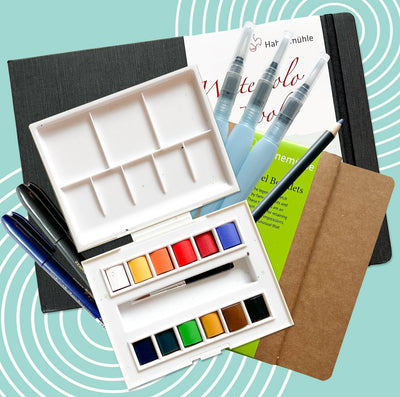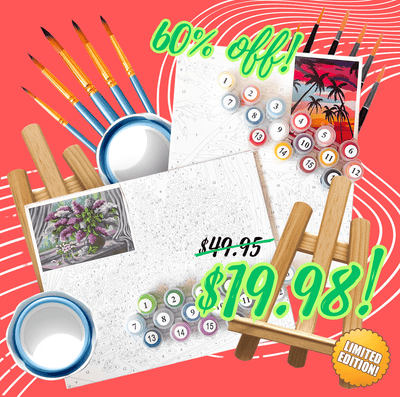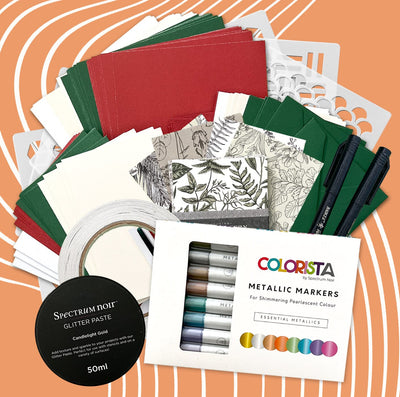Mixed media painting offers a widely flexible art system that can incorporate one or many of your artistic passions, from drawing and painting, to collage and composition.
The best way to begin a mixed media artwork is to gather your resources and materials. Since there are so many options when it comes to resources and materials, this step alone can be a little overwhelming. There is to work with that you can go about it in a few ways, depending on your artistic temperament:
- Put everything you have on the table and go wild with the ability to grasp, add, and amend whatever it seems your painting needs or can use.
- Create a concept for your painting and limit yourself to a few materials that best serve the painting and mood you're trying to bring about.

Ultimately, depending on how you like to work, there are a few indispensable tools that you must gather before you can begin your work. In addition to deciding what kinds of art media you might use, you'll also need a substrate and an adhesive that holds up to the kinds of objects or materials intended for your collage.
If you're still looking for the right tools and canvases to get started, here are a few that help us get our creative juices flowing.
Mixed Media Tools
You don't need all the tools in the world. While there is a wide variety available, you'll likely need only a few tools for each piece. Ultimately. it's up to you and your artistic style to select the tools that will best serve the concept and theme of the piece.
Your Favorite Art Supplies
Mixed media allows you to combine your favorite art media, adding dry onto wet media or vice versa. This gives you a lot of latitude to experiment with how your favorite media interact.
The most common artistic media used in mixed media painting include:
- Acrylics
- Watercolor
- Ink
- Pastels
- Graphite, Colored pencils, and Watercolor pencils
- Postermarkers and Permanent markers
- Fine liners or Brush pens
Collage Materials, Scissors, and Adhesives
Scissors are an indispensable tool for creating mixed media art. You need a pair that you can rely on to cut through both thick coarse, and thin fragile material. You might also use an Exacto knife to make careful paper cutting for collage and layering work.
Vintage books, old papers, and photo frames are solid gold for collage-based mixed media artworks. When it comes to collage, you can also bring in personal items, old letters and cards, ephemera, recycled papers, and newsprint. Some artists also use fabric swatches, with fabric glue, or at times they will use a needle and thread to stitch together elements or add in embroidery.
Finally, you'll need to decide on your glues, adhesives, and tapes. Glues come in many forms, including strong liquid glue, spray adhesives, and various tape strengths. While it's handy to have an array of adhesives, it depends on what you're attempting to attach to your painting. For example, if the majority of your collage materials are paper, then you will likely avoid liquid glue, which could cause the paper to wrinkle or rip.
Household and Low-Cost Items
When it comes to mixed media art, anything can become the subject of your artwork. Similarly, you can use anything that you find around your home or studio to make mixed media art. This allows you to keep supplies costs low, while also getting creative about the tools you use to develop your textures and effects.
Here are some common tools used for mixed media painting:
- Paintbrushes
- Straws
- Plastic knives
- Combs
- Sponges
- Bubble wrap
- Makeup wands
- Leaves, flowers, and vegetables

Mixed Media Substrates and Canvases
Paper
- Mixed Media Paper - Paper tends to have a porous surface, making it more likely to catch and hold paints and adhesives. Mixed media paper is designed for paint, collage, markers, some ink, and pastels. It may, however, buckle or break up under dense or wet paints.
- Watercolor Paper – Watercolor paper is a common choice among mixed media artists since it is thick, it may have some texture of its own, and it handles wet media exceptionally well. If you aren't working directly with watercolors, try priming the watercolor paper with acrylic gesso, to prepare it for receiving acrylics and pastels.
- Bristol Board - Bristol board is actually more of a paper than a board. This heavy-weight paper predates the popularity and production of the mixed media papers that are available today. Similar to watercolor paper, bristol board comes in a variety of weights and finishes. There are cold-pressed and hot-pressed versions, as well as smooth surfaces and vellum surfaces, which will add a little texture. This is a good option for mixed media artists who like to combine pen and ink work, light amounts of watercolor, markers and ink pens, and especially the combination of these with collage.
Boards
- Art Boards - Artboards are hard surfaces that are less likely to buckle when burdened with heavy collage objects or thick layers of wet media. An artboard will also be less likely to give way when pressed, such as with stamping or to create fine details with a pen or brush pen.
- Textured Surfaces - Textured surfaces offer a wide range of options, from textured papers to wood boards and fabrics. When properly sealed for acrylics, adhesives, and other media, these can offer an interesting surface for mixed media collage and painting. Textured surfaces will offer a head start when it comes to building up textures and creating strong and striking contrasts in your artwork.
- Cardboard - If you're practicing your techniques on a budget, cardboard might be your best bet for working on learning the techniques of mixed media art. It's not of archival quality, so don't expect it to last forever. Instead, use the cardboard like a sketchbook as an inexpensive surface to practice your art. Use a coat of gesso to seal it, and then don't be afraid to explore.
- Wood boards - A primed wood board can give your mixed media artwork a rustic feel. A layer of gesso will make the wood usable with adhesives as well as acrylic paint.
- Canvas Board - Traditional canvases can be difficult to work with when creating a mixed media art piece. This is often due to its flexibility and the reliance of the canvas on using paint and brushes, as opposed to other media. However, if you want the canvas texture in your mixed media piece or intend to do a base layer painting on canvas, we recommend opting for canvas board. In this case, the canvas is adhered to hardboard to give you the best of both worlds.
Mixed media is such a flexible field of art that the tools and perfect substrate are completely up to you, the effect you want to achieve, your art style, and the piece you want to make. These are just a few of our suggestions to get you into your flow!


